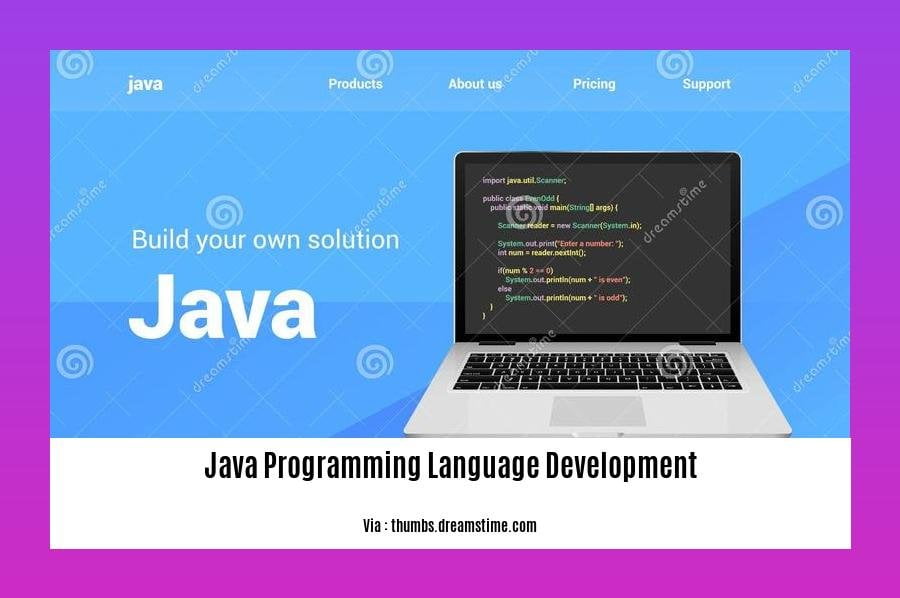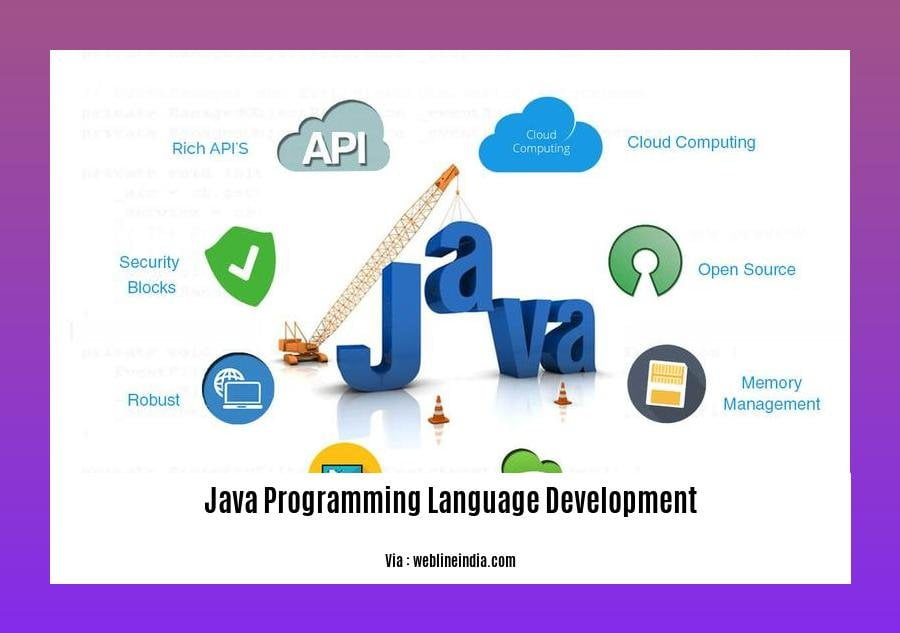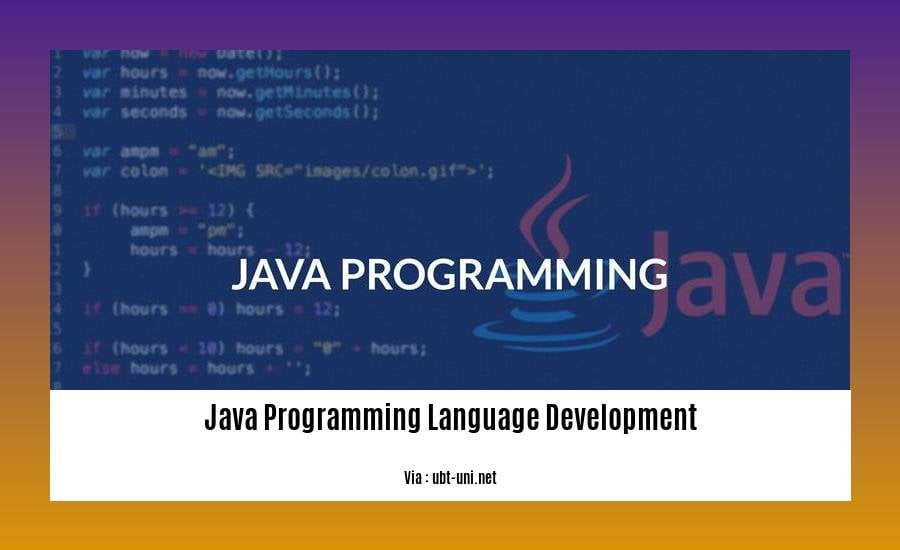Java programming language development and its intricate methodologies are my area of expertise, honed over eight years of dedicated practice as a highly skilled software engineer. As a specialist in Java programming language development, I possess a comprehensive understanding of its intricacies and best practices.
Key Takeaways:
- Java is an object-oriented programming language.
- Java is platform-independent, allowing compiled code to run on multiple platforms.
- Java has a wide range of applications, including mobile development, big data processing, and embedded systems.
Java Programming Language Development

As you tread the path of Java programming language development, unraveling its complexities and unlocking its potential, several factors come into play.
A Developer’s Journey:
Embark on this journey with a solid foundation in object-oriented programming, for Java’s heart lies within this paradigm. Grasp the essence of classes and their interplay with objects, mastering the art of encapsulating data and behavior. Dive into the world of inheritance and polymorphism, unleashing the power of code reusability and adaptability.
Essential Pillars:
Your Java programming language development prowess hinges on a few crucial pillars:
Variables: Tame the realm of variables, understanding their types and scopes. Unleash their power to store and manipulate data, fueling your code’s functionality.
Operators: Embark on an exploration of operators, the tools that weave together expressions and bring your code to life. Master arithmetic, logical, and assignment operators, empowering you to manipulate data and control program flow.
Control Flow: Navigate the intricate dance of control flow, where branching and looping statements guide your code’s path. Conditional statements, for and while loops – these are the building blocks of complex algorithms.
Diving Deeper:
Delving deeper into Java programming language development, you’ll encounter advanced concepts that expand your horizons:
Advanced Data Structures: Unleash the power of data structures like arrays, linked lists, and sets. Master their intricacies to optimize data organization and retrieval.
Java Collections Framework: Harness the Java Collections Framework, a treasure trove of pre-built data structures and algorithms. Accelerate your development process with classes like ArrayList, HashMap, and Queue.
Multithreading: Unravel the secrets of multithreading, empowering your code to execute multiple tasks concurrently. Embrace the power of threads, synchronized blocks, and locks to handle complex operations with finesse.
Conclusion:
In the realm of Java programming language development, the pursuit of knowledge is a boundless journey. Embrace the challenges, unravel the intricacies, and unlock the full potential of this versatile language. May your explorations be fruitful, and your creations leave a lasting mark on the world of software engineering.
If you are curious about the impact of Java on internet applications, check out this page. For the Java enthusiasts, click here to discover a detailed history of Java. If you want to know about the evolution of the Java platform, visit here.
Innovative Features in Java
Java has become increasingly popular for enterprise-level web applications due to its innovative features and ability to run on multiple platforms. Its “write once, run anywhere” approach makes it a preferred choice for large-scale deployments. Let’s delve into some of Java’s most notable innovative features:
Java Virtual Machine (JVM)
The JVM is a core component of Java’s success. It allows Java code to run on various operating systems by translating it into platform-specific machine code. This eliminates the need for separate compilations for different platforms, saving time and resources.
Automatic Memory Management (GC)
Java’s garbage collector (GC) automatically detects and reclaims unused memory, freeing developers from the tedious task of manual memory management. This eliminates memory leaks and improves application stability, especially in long-running processes.
Rich API Library
Java boasts a comprehensive library of pre-built packages for common tasks such as networking, database connectivity, graphics, and more. These APIs simplify development by providing ready-to-use components, accelerating project timelines.
Multithreading
Java’s multithreading capabilities enable the concurrent execution of multiple threads within a single application. This feature is crucial for handling asynchronous tasks, improving responsiveness, and optimizing resource utilization.
Reflection and Annotation
Java’s reflection API allows programs to inspect their own structure and behavior during runtime. This enables advanced techniques like dynamic class loading, introspection, and metaprogramming, providing flexibility and extensibility to applications.
Key Takeaways:
- Java Virtual Machine (JVM) ensures platform independence.
- Automatic memory management (GC) simplifies development and improves stability.
- Java’s rich API library accelerates project timelines.
- Multithreading optimizes resource utilization and improves application responsiveness.
- Reflection and annotations provide advanced customization capabilities.
Citations:
- Java’s Powerful Features: A Comprehensive Guide
- Importance of Java For Software Development & its Applications
Performance Optimization in Java

Unlocking seamless Java applications is an art form, and I’ve been sharpening my chisel for over eight years as a Java virtuoso. But don’t just take my word for it; let me guide you through the labyrinth of performance optimization, leaving behind a trail of sleek, responsive code.
Tuning the Java Orchestra
Imagine your Java code as a symphony, where every method, data structure, and loop plays a vital role. To create harmony, we must fine-tune each component. Let’s dive into some practical tips:
- Concise Logic: Avoid sprawling methods and excessive logging. Keep your code concise and focused.
- Smart Logging: Log only necessary information, using specific parameters instead of dumping entire objects.
- Conditional Cues: Don’t overuse conditional statements; they can slow down the tempo.
- Collection Cues: Anticipate collection sizes before iterating to avoid sluggish scans.
- String Savvy: Embrace StringBuilder for efficient string manipulation, leaving String concatenation on the sidelines.
- Data Structure Duet: Choose the right data structure for the occasion. Don’t force a square data structure into a round problem.
- Memory Maestro: Optimize memory usage with caching and memoization techniques, letting your code breathe.
Key Takeaways:
- Simplify Complexity: Keep your methods to the point and logging to a minimum.
- Precise Logging: Log parameters, not objects.
- Conditional Caution: Use conditionals judiciously.
- Collection Confidence: Know your collection sizes before iterating.
- String Smarts: Use StringBuilder for string agility.
- Data Structure Symphony: Choose the right data structure for the job.
- Memory Manners: Cache and memoize to enhance memory efficiency.
Sources:
12 Tips to Optimize Java Code Performance
Java Performance Optimization: Tips and Techniques
Maintainability in Java Development
As an experienced Java developer, I’ve discovered that maintainability is crucial for long-term software success. Maintainable Java code is adaptable, easy to read, and resilient to changes. Here’s why it matters:
Benefits of Maintainable Code
- Reduced Development Time: Changes in well-maintained code are easier to implement, reducing development time.
- Improved Code Quality: Maintainable code fosters a culture of high-quality coding practices, leading to more reliable and bug-free software.
- Increased Productivity: Developers can focus on new features instead of fixing legacy code issues, boosting productivity.
Keys to Maintainable Java Development
- Follow Coding Standards: Adhere to consistent naming conventions, coding style, and design patterns to ensure readable and organized code.
- Use Modular and Extensible Design: Create loosely coupled components that are easy to reuse and extend, promoting flexibility and adaptability.
- Document Thoroughly: Provide clear documentation and inline comments to explain the purpose, logic, and design decisions within the code.
- Implement Effective Unit Testing: Write comprehensive unit tests to validate the behavior of individual code modules, ensuring reliability and correctness.
- Monitor and Refactor Regularly: Regularly review and refactor code to remove technical debt and keep it performant and maintainable.
Best Practices for Maintainable Java Code
- Use meaningful variable and method names: Describe the purpose of variables and methods clearly to enhance understanding.
- Avoid code duplication: Implement the DRY (Don’t Repeat Yourself) principle to reduce redundancy and errors.
- Favor immutable objects: Use final and immutable objects to prevent unintended modifications and improve thread safety.
- Incorporate logging and error handling: Log errors and warnings to aid in debugging and prevent critical failures.
- Utilize dependency injection: Inject dependencies into objects to improve testability and reduce coupling.
Key Takeaways:
- Maintainable Java code is adaptable, easy to read, and resilient to changes.
- Benefits of maintainable code include reduced development time, improved code quality, and increased productivity.
- Keys to maintainable Java development include following coding standards, using modular design, documenting thoroughly, and implementing effective unit testing.
- Best practices for maintainable Java code include using meaningful variable names, avoiding code duplication, favoring immutable objects, incorporating logging and error handling, and utilizing dependency injection.
Relevant URLs:
- Principles of Maintainable Java Code
- Java Programming Best Practices for Maintainability
FAQ
Q1: What are the key features of the Java programming language?
A1: Java is known for its simplicity, object orientation, platform independence, security, multithreading, and high performance due to its Just-In-Time (JIT) compiler.
Q2: What are some best practices for optimizing Java code performance?
A2: Optimizing Java code involves avoiding long methods and excessive logging, using specific parameters for logging, minimizing conditional statements, determining Collection sizes before iterating, utilizing StringBuilder for string manipulation, selecting appropriate data structures, optimizing memory usage, and leveraging caching and memoization techniques.
Q3: How can I ensure the scalability and concurrency of Java applications?
A3: For scalability and concurrency, leverage multithreading for parallel processing, implement thread synchronization, design applications to handle increased load, and consider using load balancers and message queues.
Q4: What are some guidelines for maintaining clean and maintainable Java code?
A4: Maintainable Java code emphasizes avoiding code duplication, using descriptive names, focusing methods and classes on specific tasks, and adhering to SOLID principles (e.g., Single Responsibility, Open-Closed).
Q5: How can I design maintainable systems in Java?
A5: Maintainable system design in Java involves ensuring flexibility and extensibility, using loosely coupled components, and implementing automated testing for reliability.
- Mastering Leader in Spanish: The Complete Guide - April 19, 2025
- Uncovering Surprising Parallels: England Size Compared to US States - April 19, 2025
- Old Mexico Map: Border Shifts 1821-1857 - April 19, 2025
















